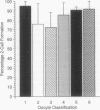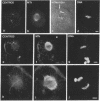Abstract
The centrosome, the microtubule-organizing center of the cell, is introduced typically by the sperm at fertilization. In some mammals, however, this paternal pattern of inheritance appears to be violated. The hypothesis that the centrosome is maternally inherited was tested during parthenogenesis, polyspermy, and polygyny as well as after recovery from microtubule inhibition at first mitosis. During parthenogenesis the paternal contribution was absent, and in polyspermy the paternal contribution was multiplied. Haploid and diploid parthenogenotes as well as polyspermic and digynic fertilized eggs each segregated their centrosomes to organize a bipolar mitotic apparatus. Oocytes recovering from a nocodazole block formed two normal bipolar mitotic apparatus; the paternal chromosomes aligned at one spindle equator, while the maternal chromosomes were found at the other. These results show that the centrosome is maternally inherited from cytoplasmic sites in the mouse. The evolutionary switch from paternal to maternal inheritance in mammals might be related to the additional dangers that parthenogenesis represents: a threat to the life of the mother as well as to the life of the fetus.
Full text
PDF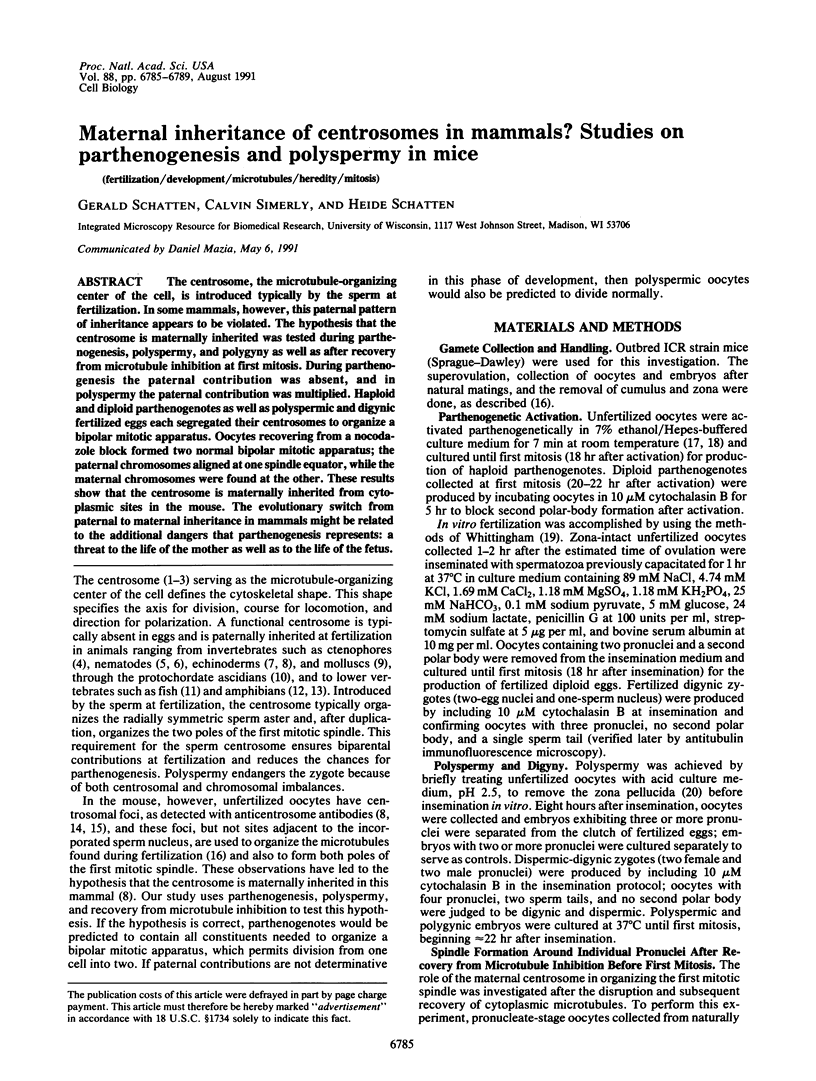
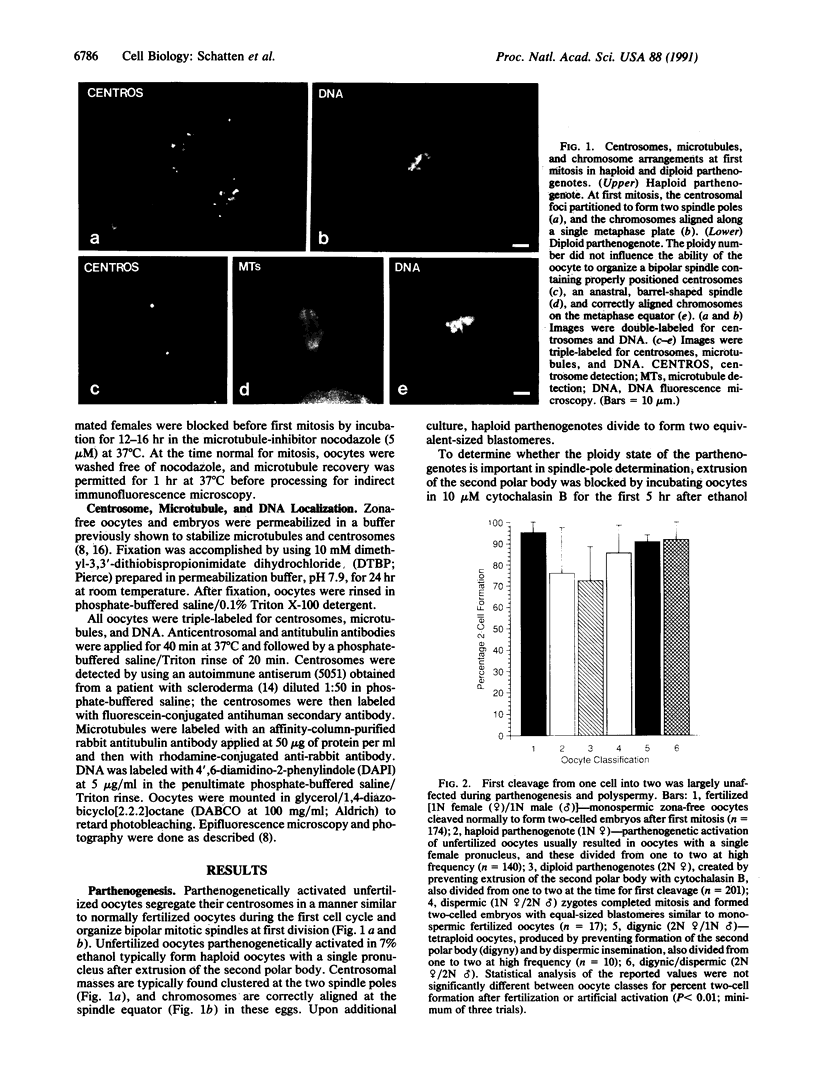
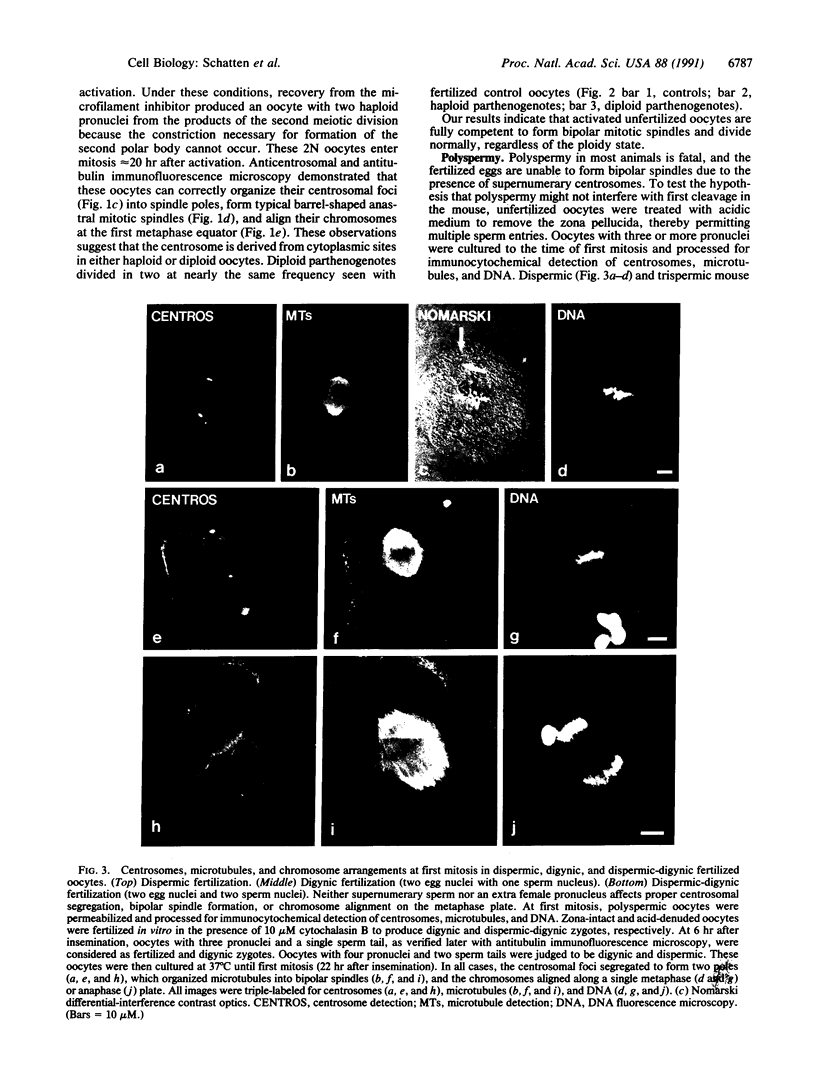
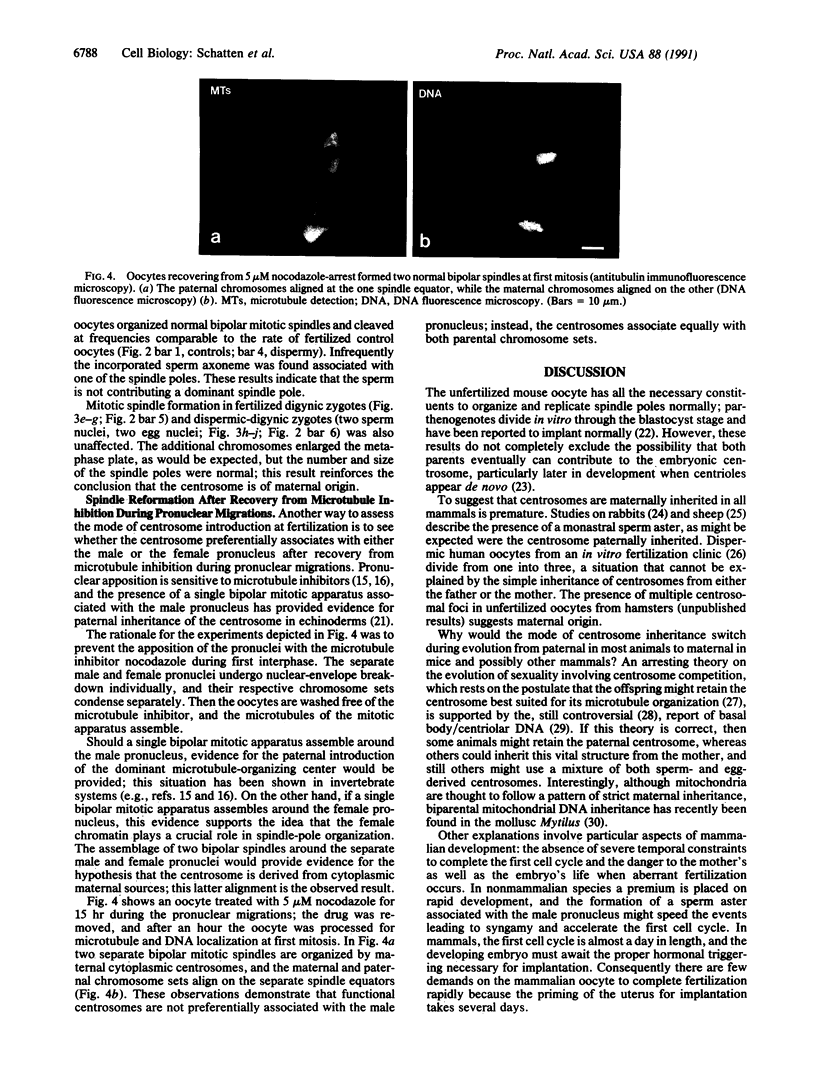
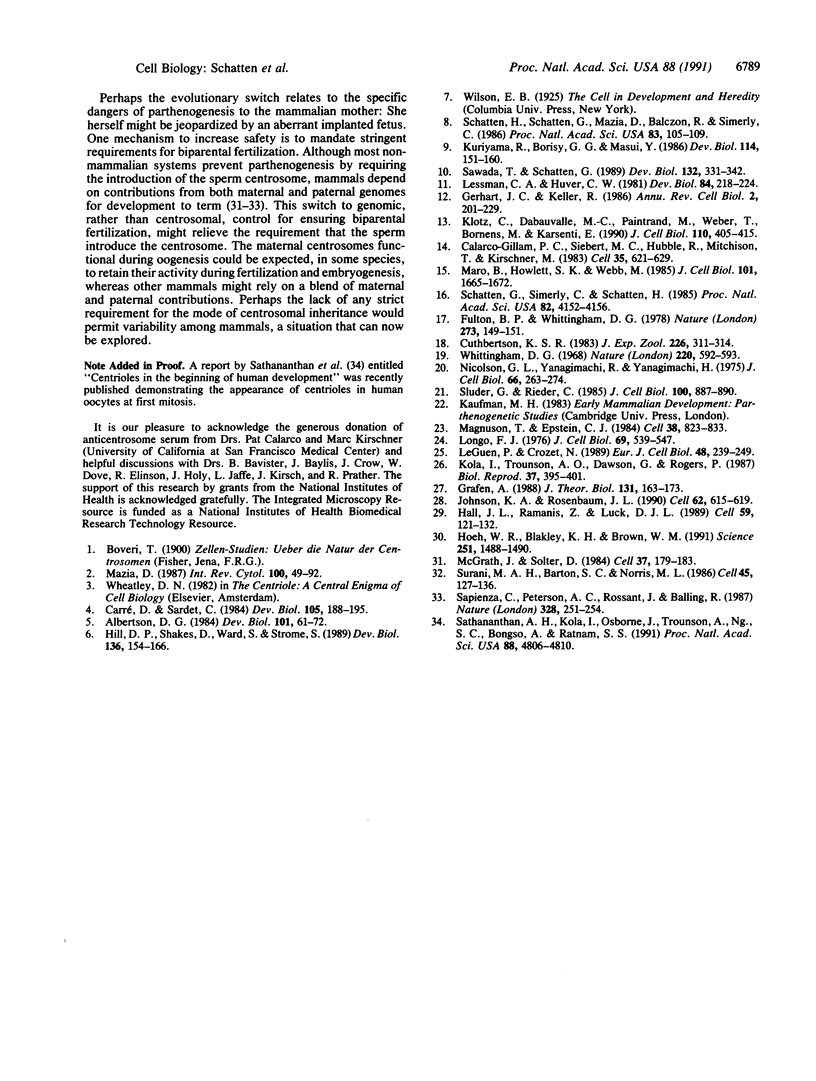
Images in this article
Selected References
These references are in PubMed. This may not be the complete list of references from this article.
- Albertson D. G. Formation of the first cleavage spindle in nematode embryos. Dev Biol. 1984 Jan;101(1):61–72. doi: 10.1016/0012-1606(84)90117-9. [DOI] [PubMed] [Google Scholar]
- Calarco-Gillam P. D., Siebert M. C., Hubble R., Mitchison T., Kirschner M. Centrosome development in early mouse embryos as defined by an autoantibody against pericentriolar material. Cell. 1983 Dec;35(3 Pt 2):621–629. doi: 10.1016/0092-8674(83)90094-6. [DOI] [PubMed] [Google Scholar]
- Carré D., Sardet C. Fertilization and early development in Beroe ovata. Dev Biol. 1984 Sep;105(1):188–195. doi: 10.1016/0012-1606(84)90274-4. [DOI] [PubMed] [Google Scholar]
- Cuthbertson K. S. Parthenogenetic activation of mouse oocytes in vitro with ethanol and benzyl alcohol. J Exp Zool. 1983 May;226(2):311–314. doi: 10.1002/jez.1402260217. [DOI] [PubMed] [Google Scholar]
- Fulton B. P., Whittingham D. G. Activation of mammalian oocytes by intracellular injection of calcium. Nature. 1978 May 11;273(5658):149–151. doi: 10.1038/273149a0. [DOI] [PubMed] [Google Scholar]
- Gerhart J., Keller R. Region-specific cell activities in amphibian gastrulation. Annu Rev Cell Biol. 1986;2:201–229. doi: 10.1146/annurev.cb.02.110186.001221. [DOI] [PubMed] [Google Scholar]
- Grafen A. A centrosomal theory of the short term evolutionary maintenance of sexual reproduction. J Theor Biol. 1988 Mar 21;131(2):163–173. doi: 10.1016/s0022-5193(88)80233-9. [DOI] [PubMed] [Google Scholar]
- Hall J. L., Ramanis Z., Luck D. J. Basal body/centriolar DNA: molecular genetic studies in Chlamydomonas. Cell. 1989 Oct 6;59(1):121–132. doi: 10.1016/0092-8674(89)90875-1. [DOI] [PubMed] [Google Scholar]
- Hill D. P., Shakes D. C., Ward S., Strome S. A sperm-supplied product essential for initiation of normal embryogenesis in Caenorhabditis elegans is encoded by the paternal-effect embryonic-lethal gene, spe-11. Dev Biol. 1989 Nov;136(1):154–166. doi: 10.1016/0012-1606(89)90138-3. [DOI] [PubMed] [Google Scholar]
- Hoeh W. R., Blakley K. H., Brown W. M. Heteroplasmy suggests limited biparental inheritance of Mytilus mitochondrial DNA. Science. 1991 Mar 22;251(5000):1488–1490. doi: 10.1126/science.1672472. [DOI] [PubMed] [Google Scholar]
- Johnson K. A., Rosenbaum J. L. The basal bodies of Chlamydomonas reinhardtii do not contain immunologically detectable DNA. Cell. 1990 Aug 24;62(4):615–619. doi: 10.1016/0092-8674(90)90105-n. [DOI] [PubMed] [Google Scholar]
- Klotz C., Dabauvalle M. C., Paintrand M., Weber T., Bornens M., Karsenti E. Parthenogenesis in Xenopus eggs requires centrosomal integrity. J Cell Biol. 1990 Feb;110(2):405–415. doi: 10.1083/jcb.110.2.405. [DOI] [PMC free article] [PubMed] [Google Scholar]
- Kola I., Trounson A., Dawson G., Rogers P. Tripronuclear human oocytes: altered cleavage patterns and subsequent karyotypic analysis of embryos. Biol Reprod. 1987 Sep;37(2):395–401. doi: 10.1095/biolreprod37.2.395. [DOI] [PubMed] [Google Scholar]
- Kuriyama R., Borisy G. G., Masui Y. Microtubule cycles in oocytes of the surf clam, Spisula solidissima: an immunofluorescence study. Dev Biol. 1986 Mar;114(1):151–160. doi: 10.1016/0012-1606(86)90391-x. [DOI] [PubMed] [Google Scholar]
- Le Guen P., Crozet N. Microtubule and centrosome distribution during sheep fertilization. Eur J Cell Biol. 1989 Apr;48(2):239–249. [PubMed] [Google Scholar]
- Lessman C. A., Huver C. W. Quantification of fertilization-induced gamete changes and sperm entry without egg activation in a teleost egg. Dev Biol. 1981 May;84(1):218–224. doi: 10.1016/0012-1606(81)90386-9. [DOI] [PubMed] [Google Scholar]
- Longo F. J. Sperm aster in rabbit zygotes: its structure and function. J Cell Biol. 1976 Jun;69(3):539–547. doi: 10.1083/jcb.69.3.539. [DOI] [PMC free article] [PubMed] [Google Scholar]
- Magnuson T., Epstein C. J. Oligosyndactyly: a lethal mutation in the mouse that results in mitotic arrest very early in development. Cell. 1984 Oct;38(3):823–833. doi: 10.1016/0092-8674(84)90277-0. [DOI] [PubMed] [Google Scholar]
- Maro B., Howlett S. K., Webb M. Non-spindle microtubule organizing centers in metaphase II-arrested mouse oocytes. J Cell Biol. 1985 Nov;101(5 Pt 1):1665–1672. doi: 10.1083/jcb.101.5.1665. [DOI] [PMC free article] [PubMed] [Google Scholar]
- Mazia D. The chromosome cycle and the centrosome cycle in the mitotic cycle. Int Rev Cytol. 1987;100:49–92. doi: 10.1016/s0074-7696(08)61698-8. [DOI] [PubMed] [Google Scholar]
- McGrath J., Solter D. Completion of mouse embryogenesis requires both the maternal and paternal genomes. Cell. 1984 May;37(1):179–183. doi: 10.1016/0092-8674(84)90313-1. [DOI] [PubMed] [Google Scholar]
- Nicolson G. L., Yanagimachi R., Yanagimachi H. Ultrastructural localization of lectin-binding sites on the zonae pellucidae and plasma membranes of mammalian eggs. J Cell Biol. 1975 Aug;66(2):263–274. doi: 10.1083/jcb.66.2.263. [DOI] [PMC free article] [PubMed] [Google Scholar]
- Sapienza C., Peterson A. C., Rossant J., Balling R. Degree of methylation of transgenes is dependent on gamete of origin. Nature. 1987 Jul 16;328(6127):251–254. doi: 10.1038/328251a0. [DOI] [PubMed] [Google Scholar]
- Sathananthan A. H., Kola I., Osborne J., Trounson A., Ng S. C., Bongso A., Ratnam S. S. Centrioles in the beginning of human development. Proc Natl Acad Sci U S A. 1991 Jun 1;88(11):4806–4810. doi: 10.1073/pnas.88.11.4806. [DOI] [PMC free article] [PubMed] [Google Scholar]
- Sawada T., Schatten G. Effects of cytoskeletal inhibitors on ooplasmic segregation and microtubule organization during fertilization and early development in the ascidian Molgula occidentalis. Dev Biol. 1989 Apr;132(2):331–342. doi: 10.1016/0012-1606(89)90230-3. [DOI] [PubMed] [Google Scholar]
- Schatten G., Simerly C., Schatten H. Microtubule configurations during fertilization, mitosis, and early development in the mouse and the requirement for egg microtubule-mediated motility during mammalian fertilization. Proc Natl Acad Sci U S A. 1985 Jun;82(12):4152–4156. doi: 10.1073/pnas.82.12.4152. [DOI] [PMC free article] [PubMed] [Google Scholar]
- Schatten H., Schatten G., Mazia D., Balczon R., Simerly C. Behavior of centrosomes during fertilization and cell division in mouse oocytes and in sea urchin eggs. Proc Natl Acad Sci U S A. 1986 Jan;83(1):105–109. doi: 10.1073/pnas.83.1.105. [DOI] [PMC free article] [PubMed] [Google Scholar]
- Sluder G., Rieder C. L. Centriole number and the reproductive capacity of spindle poles. J Cell Biol. 1985 Mar;100(3):887–896. doi: 10.1083/jcb.100.3.887. [DOI] [PMC free article] [PubMed] [Google Scholar]
- Surani M. A., Barton S. C., Norris M. L. Nuclear transplantation in the mouse: heritable differences between parental genomes after activation of the embryonic genome. Cell. 1986 Apr 11;45(1):127–136. doi: 10.1016/0092-8674(86)90544-1. [DOI] [PubMed] [Google Scholar]
- Whittingham D. G. Fertilization of mouse eggs in vitro. Nature. 1968 Nov 9;220(5167):592–593. doi: 10.1038/220592a0. [DOI] [PubMed] [Google Scholar]




